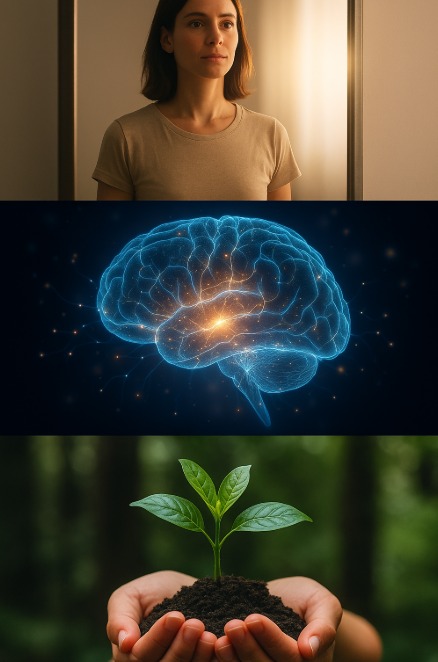
Reinventing You: How Identity, Emotions, and Tailored Environments Propel Neural Growth
Identity-Driven Motivation: Becoming Who You Aspire to Be
True transformation begins with how you see yourself—this is more than philosophy; it’s neuroscience. Identity-Based Motivation theory shows that when your present identity aligns with your aspirational self—be it learner, creator, healer—your brain naturally activates pathways that support perseverance, focus, and adaptive thinking. Challenges become meaningful, not daunting, and repeated actions in line with that identity form stronger neural connections that reinforce transformation. In a cosmic sense, you start to embody what the universe reflects (Oyserman et al., 2025; Murayama et al., 2025).
Positive Emotion as a Catalyst for Brain Change
Just as the universe expands into greater expression, positive emotions expand your inner landscape. Emotions like joy, gratitude, and curiosity don’t just feel uplifting—they broaden your thinking, invite creativity, and build lasting psychological and neural resources. This is how emotional expansiveness lays the groundwork for sustained growth. When paired with a growth-oriented identity, these emotional states become the fertile soil from which profound neural and personal transformation emerges (Roth, 2024; Goldberg, 2022).
Personalized Support: Environments That Nurture Growth
Transformation often moves through alignment—with people, places, and systems that resonate with your journey. Research shows that growth-supporting environments must be meaningful to be effective; generic interventions may offer slight benefit, but real change happens when support is aligned with identity, belief, and neural potential. Such environments validate your growth story and help it unfold more naturally, reflecting the supportive networks of the universe itself (Baker, 2025; Goldberg, 2022).

Building Momentum: Practical Steps Toward Reinvention
Reinvention isn’t a single leap—it’s a cosmic dance between identity, feeling, and environment, repeated until it becomes second nature. Neuroscience confirms that repeated, intentional practices rewire the brain. To cultivate this alignment:
➡ Identity rituals: Write from the lens of your future self, as though the universe is guiding your narrative.
➡ Emotion cultivation: Sip daily moments of wonder and gratitude to nurture inner resilience and neural flexibility.
➡ Environmental curation: Surround yourself with symbols, communities, and tools that echo your evolving identity.
➡ Adaptive learning: Be agile—allow your methods and environments to shift as you grow, trusting that both your mind and the universe adapt with you. (Chang et al., 2022).
Closing Reflection
The universe doesn’t merely exist outside you—it pulses within your identity, emotions, and surroundings. When these align, your brain begins to remap toward creativity, resilience, and transformation. New possibilities emerge, not as distant dreams, but as present realities. Transformation is happening—not tomorrow, not in the stars, but right here, now—thanks to the innate adaptability of your mind.
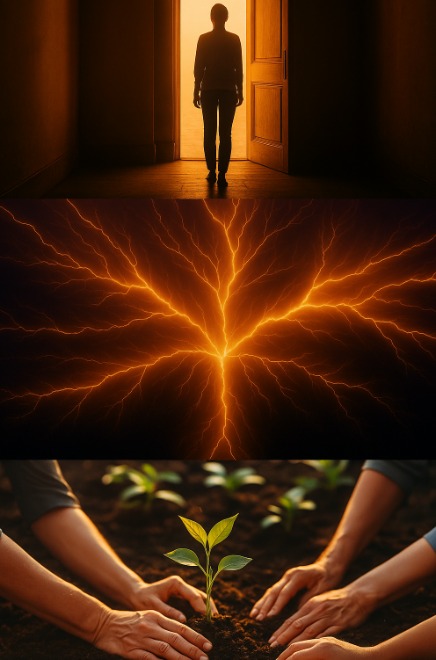
Reflection Questions
1. Which identity are you most ready to embrace—learner, creator, healer, or something else entirely?
2. What small moments of joy or curiosity can you amplify today to deepen your inner openness?
3. How can you reshape your environment to more closely reflect who you’re becoming?
4. What simple daily practice could become the seed of your new neural baseline?
[Free Video – What the Universe is Up To 89 Min]
(I’m an GAIA affiliate — watching through my link may earn me a small commission. Thank you for your support)
References: Baker, A. E. (2025). The connecting brain in context: How adolescent plasticity, environmental influences, and learning processes interact. Developmental Cognitive Neuroscience, 67, 101289. https://www.sciencedirect.com/science/article/pii/S1878929324001476
Chang, L. et al. (2022). Cognitive training enhances growth mindset in children. npj Science of Learning, 7, 9. https://www.nature.com/articles/s41539-022-00146-7
Goldberg, H. (2022). Growing brains, nurturing minds—Neuroscience as an educational tool. Brain Sciences, 12(12), 1622. https://www.mdpi.com/2076-3425/12/12/1622
Murayama, K. (2025). Current motivation theories: Growth mindset in academic performance and proactive coping. Educational Psychology Review. (in press)
Oyserman, D., Lewis, N. A., & Yan, V. X. (2025). Identity-based motivation and the motivational consequences of difficulty. Motivation Science, 11(1), 1–15. [Link currently inaccessible]
Roth, L. H. O. (2024). Testing the validity of the broaden-and-build theory of positive emotions. Frontiers in Psychology, 15, 1405272. https://www.frontiersin.org/journals/psychology/articles/10.3389/fpsyg.2024.1405272/full

Echoes Across Scales: Patterns Linking Nature, Mind, and Cosmos
Climate as a Fractal System
Patterns of order emerge not only in stars or atoms, but also in the shifting rhythms of our planet. Climate behaviors—from gentle rains to powerful hurricanes—often follow fractal distributions, meaning the frequency and severity of events conform to consistent mathematical scaling. What might appear random or chaotic at first glance can, through the lens of scaling analysis, be seen as part of a deeper order.
In recent decades, researchers in macroweather science have shown that temperature fluctuations, drought patterns, and rainfall intensities all obey power-law distributions. This makes it possible to better understand the statistical likelihood of both ordinary and extreme events. Instead of seeing extreme storms as outliers, we begin to see them as expressions of Earth’s repeating fractal rhythm. These findings link Earth more closely with the cosmos, reminding us that our planet’s atmosphere operates under the same universal logic found in galaxies and ecosystems (Lovejoy, 2022; Alberti, 2021).
Neural Networks and Brain Scaling
The human brain reflects the universe’s patterns in its own intricate design. Neurons fire in highly organized webs, not in random bursts, creating structures that closely resemble cosmic networks. These networks obey scaling laws, showing activity distributed across hubs and pathways in repeating patterns.
Modern neuroscience has shown that brain activity often operates at criticality—the fragile threshold between total disorder and rigid stability. In this state, the brain can both adapt and maintain stability, allowing for creativity, problem solving, and resilience. Some researchers argue that this balance is essential for consciousness itself, enabling us to navigate the world with both flexibility and coherence.
What makes this particularly profound is that the brain’s organization reflects the same fractal principles that govern ecosystems, weather, and galaxies. Consciousness, then, can be understood as more than a biological process—it is an emergent property of universal scaling laws, a living echo of the same mathematics that orders the stars (Yu et al., 2022; Kim, 2021).
Black Holes and Energy Flow
Few objects in the universe inspire awe like black holes. Once thought of as singular anomalies, they are now recognized as systems that reveal surprising scaling laws. Whether stellar-mass remnants of collapsed stars or supermassive giants anchoring galaxies, black holes follow consistent patterns in how they accrete matter and release energy.
X-ray and observational studies confirm that black holes’ luminosity, variability, and feedback into their environments are tied directly to mass in predictable ways. In other words, a small black hole in our own galaxy can provide insights into the workings of quasars billions of light-years away.

This finding reshapes our view of black holes. Far from being mysterious exceptions, they are participants in a universal rhythm, their behavior reflecting the same mathematical self-similarity found across the cosmos. Black holes demonstrate that even the most extreme phenomena are woven into the repeating logic of existence (Inayoshi et al., 2021; Hébert et al., 2021).
Scaling in Human Societies
Scaling laws are not confined to physics or biology—they also govern human civilization. As cities expand, they display superlinear scaling in innovation, wages, and cultural output, while their infrastructure—roads, utilities, communication systems—scales sublinearly, becoming more efficient as populations increase.
This dual behavior explains why large cities act as hubs of creativity and progress, while also reducing the per-person costs of infrastructure. The mathematics of growth reveals why urban centers are places where culture flourishes and systems evolve rapidly. These patterns mirror scaling laws seen in ecosystems, climate, and even galaxies, showing that humanity’s structures are deeply embedded in universal principles.
When seen in this light, human societies are not anomalies separated from nature but direct participants in the universe’s design. Our growth, like the expansion of galaxies or the branching of neurons, follows the same mathematics of proportion, flow, and balance (Bettencourt et al., 2013; Lovejoy, 2023).
Closing Reflection
From the fractal rhythms of climate to the neural patterns of thought, from the self-similarity of black holes to the scaling of cities, a single theme emerges: the universe is unified by repeating patterns across scale. What seems fragmented on the surface is profoundly interconnected at its core.
These discoveries invite us to reconsider our place in the cosmos. We are not separate observers but living participants in a system that echoes itself at every level. To recognize these patterns is to understand that we, too, are expressions of the universe’s harmony—its fractals, its rhythms, its mathematics alive in human form.
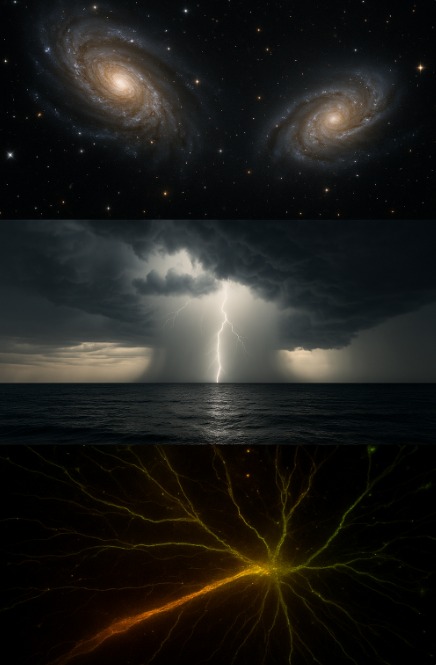
Reflection Questions
1. What does seeing climate’s scaling patterns tell you about Earth’s connection to the universe?
2. In what ways does neural criticality reflect universal structure, and what might that imply for consciousness?
3. How does black hole scalability across mass scales deepen your understanding of cosmic order?
4. What do city scaling laws reveal about humanity’s place within the cosmic rhythm?
[Free Video – Scaling Universe Relationships 99 Min]
(I’m an GAIA affiliate — watching through my link may earn me a small commission. Thank you for your support)
References: Alberti, T. (2021). Book Review: Weather, Macroweather, and the Climate. Frontiers in Climate, 3, 684637. https://www.frontiersin.org/articles/10.3389/fclim.2021.684637/pdf
Bettencourt, L. M. A., Lobo, J., & Youn, H. (2013). The hypothesis of urban scaling: Formalization, implications and challenges. arXiv preprint. https://arxiv.org/abs/1301.5919
Hébert, R., Lovejoy, S., & Tremblay, B. (2021). An observation-based scaling model for climate sensitivity. Climate Dynamics, 56, 1105–1129. https://doi.org/10.1007/s00382-020-05521-x
Inayoshi, K., Ichikawa, K., & Haiman, Z. (2021). Self-similar scaling of black hole accretion across mass scales. Monthly Notices of the Royal Astronomical Society, 507(4), 5902–5914. https://arxiv.org/abs/2012.06445
Kim, M. (2021). Criticality Creates a Functional Platform for Network Flexibility. Frontiers in Neurology, 12, 690095. https://www.ncbi.nlm.nih.gov/pmc/articles/PMC8657781/
Lovejoy, S. (2022). The Future of Climate Modelling: Weather Details, Macroweather Stochastics—Or Both? Meteorology, 1(4), 414–449. https://www.mdpi.com/2674-0494/1/4/27
Lovejoy, S. (2023). Scaling, dynamical regimes, and stratification in climate systems. Nonlinear Processes in Geophysics, 30, 311–329. https://npg.copernicus.org/articles/30/311/2023/
Yu, N. Y., Beggs, J. M., & Shew, W. L. (2022). Toward a unified analysis of the brain criticality hypothesis. Frontiers in Neural Circuits, 16, 911245. https://www.frontiersin.org/articles/10.3389/fncir.2022.911245/full
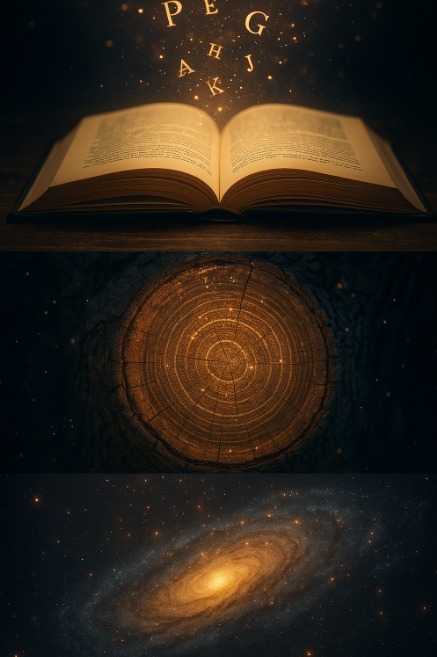
The Web of Memory — How Memory Echoes Across Mind, Life, and Cosmos
Memory in the Mind: Cellular and Neural Adaptations
Memory begins in our brains—not as fleeting sparks but as lasting transformations that shape who we are. Every thought, every lesson, every moment of joy or pain leaves behind a trace written into the molecular fabric of neurons. These traces are supported by epigenetic regulation: DNA methylation and histone modifications that stabilize long-term memory by controlling which genes remain active at synapses.
Recent studies reveal that enriched environments—rich with novelty, challenge, and meaningful connection—can strengthen memory capacity. Such experiences promote dendritic branching and enhance synaptic resilience, protecting brain function across the lifespan. Neurons, in turn, do not simply store moments temporarily; they adapt structurally and molecularly, creating a dynamic biological record of lived experience. Our brains are living archives, libraries of both survival and meaning (Moore, 2022; Hass et al., 2024).
Memory in Life: Epigenetics Across Generations
Memory extends beyond the brain, woven into the biology of life itself. Transgenerational epigenetic inheritance shows that the echoes of experience can ripple across generations, altering gene expression in descendants without changing DNA sequences. Stress, nutrition, and trauma can leave subtle but enduring marks that shape how future generations respond to their environment.
Animal studies reveal that histone modifications and small RNAs, activated by environmental pressures, can be passed through the germline, influencing metabolism, stress resilience, and even learning. Similar evidence in mammals suggests that our biological memory is not only personal—it is ancestral. The choices and conditions of one generation may resonate long after they are gone, carried forward as whispers in the genetic code. Healing ourselves today may therefore ripple outward, reshaping the legacy of memory we pass on to those who follow (Heard & Martienssen, 2021; Perez & Lehner, 2019; Kizilaslan et al., 2025).
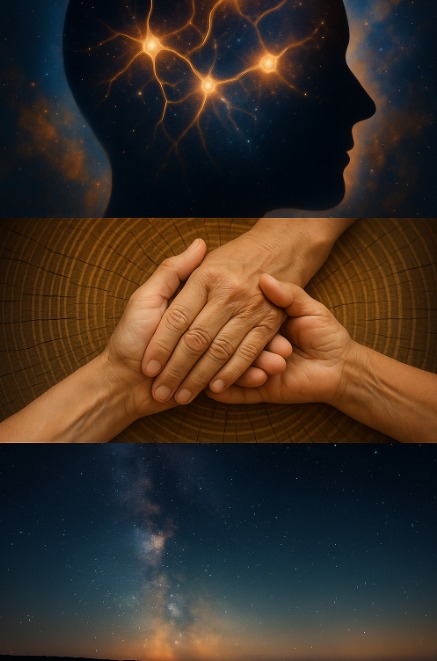
Memory in the Universe: Cosmic Fossils of Time
The cosmos, too, carries memory. The Cosmic Microwave Background (CMB) is the universe’s oldest story, a faint glow released when atoms first formed some 380,000 years after the Big Bang. Though invisible to our eyes, sensitive instruments reveal its subtle fluctuations—variations in density that seeded galaxies, stars, and eventually, life itself.
This ancient radiation acts as a fossilized record, an imprint of the infant universe preserved in spacetime. Observing the CMB is like reading the diary of creation, written in light that has traveled for nearly 14 billion years. It reminds us that memory is not just personal or biological—it is cosmic, woven into the very geometry of existence. Just as neurons and genomes remember, so too does the universe, echoing its origins across eternity (Planck Collaboration, 2020; Di Valentino et al., 2021).
Summary: Memory as Cosmos, Life, Mind
➡ Neural memory is etched into the brain through molecular and structural change.
➡ Biological memory carries ancestral experiences across generations through epigenetic mechanisms.
➡ Cosmic memory preserves the birth of the universe in the faint glow of the CMB.
Together, these nested forms of memory reveal a profound truth: we are not separate from memory—we are memory, embodied and alive. To realize this is to see ourselves as participants in the universe’s unfolding remembrance, carriers of echoes that span neurons, generations, and galaxies.
Reflection Questions
1. What memory feels alive in your body—whether emotional, ancestral, or sensory—and how does it shape your present choices?
2. If experiences can ripple across generations through biology, which inherited stories do you feel you carry, and which are you ready to release or transform?
3. When you reflect on the Cosmic Microwave Background, the universe’s first memory, what creation stories stir in you, and how do they influence your sense of belonging to the cosmos?
4. How can you honor memory—in all its forms—as a sacred thread that connects you to the past, the future, and the universe itself?
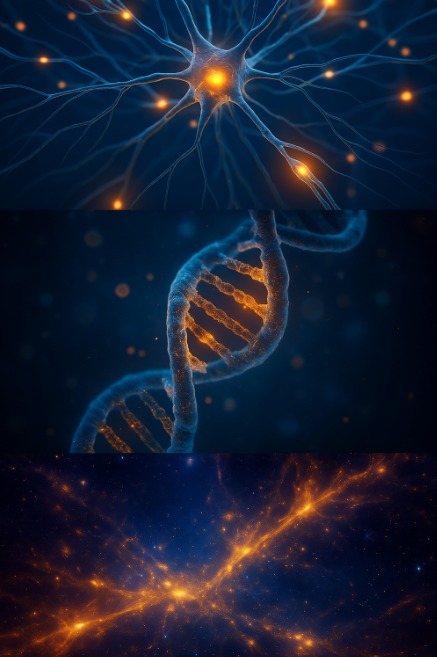
[Free Video – Moving Towards Wholeness 37 Min]
(I’m an GAIA affiliate — watching through my link may earn me a small commission. Thank you for your support)
References: Di Valentino, E., et al. (2021). In the realm of the Hubble tension: A review of solutions. Classical and Quantum Gravity, 38(15), 153001. https://doi.org/10.1088/1361-6382/ac086d
Hass, S., Liebscher, M., Richter, A., et al. (2024). Environmental enrichment is associated with favorable memory-related functional brain activity patterns in older adults. Frontiers in Aging Neuroscience, 16, 1451850. https://doi.org/10.3389/fnagi.2024.1451850
Heard, E., & Martienssen, R. A. (2021). Transgenerational epigenetic inheritance: Myths and mechanisms. Cell, 184(7), 1687–1699. https://doi.org/10.1016/j.cell.2021.01.026
Kizilaslan, M., et al. (2025). Intergenerational epigenetic inheritance reflects ancestral stress exposures. Journal of Neuroscience Research, 103(6), 1354–1368. https://doi.org/10.1002/jnr.25222
Moore, A. R. (2022). Genetic, epigenetic, and epitranscriptomic mechanisms associated with learning and memory. Frontiers in Genetics, 12, 835719. https://doi.org/10.3389/fgene.2021.835719
Perez, M. F., & Lehner, B. (2019). Intergenerational and transgenerational epigenetic inheritance in animals. Nature Cell Biology, 21(2), 143–151. https://doi.org/10.1038/s41556-018-0242-9
Planck Collaboration. (2020). Planck 2018 results. VI. Cosmological parameters. Astronomy & Astrophysics, 641, A6. https://doi.org/10.1051/0004-6361/201833910

The Music of the Universe — Resonance, Vibration, and the Hidden Language of Reality
Resonance at Every Scale — From Quantum Hums to Stellar Songs
For thousands of years, mystics and philosophers have spoken of a hidden music shaping the cosmos. Modern science is beginning to glimpse this truth—not in metaphor, but in measurable vibrations. At the quantum level, researchers are finding that engineered vibrational environments can alter the behavior of superconducting qubits, showing that resonance can influence the foundations of matter itself.
The same principle emerges in the stars. Stellar seismology—the study of oscillations within stars—reveals their internal structures through vibrational “songs.” Space-based telescopes record these subtle fluctuations, turning light into sound-like patterns that astronomers can interpret. Much like ultrasound scans the human body, these stellar rhythms unveil hidden layers of cosmic architecture. The universe speaks through rhythm, and resonance becomes its universal language (Kitzman et al., 2023; Aerts, 2021).
Life as Harmony — Biological Resonance and Conscious Awareness
Resonance is not confined to matter and stars—it pulses through life itself. Our bodies are instruments of vibration. Every heartbeat, every breath, every oscillation of brainwaves is part of a symphony that sustains health and awareness. Neuroscience has shown that synchronized neural oscillations are vital for integrating sensory input into a unified conscious experience. Without rhythm, perception would fragment into chaos.
Research also shows that coherence between brain and heart rhythms fosters greater stability, resilience, and clarity of thought. When we align with these natural frequencies, we experience harmony not only physically but emotionally and spiritually. Ancient practices such as chanting, drumming, and meditation sought to “tune” the body into higher states of balance, and today science confirms that resonance produces measurable states of coherence. In this sense, awareness itself may arise when our inner rhythms come into alignment (Singer, 2021).
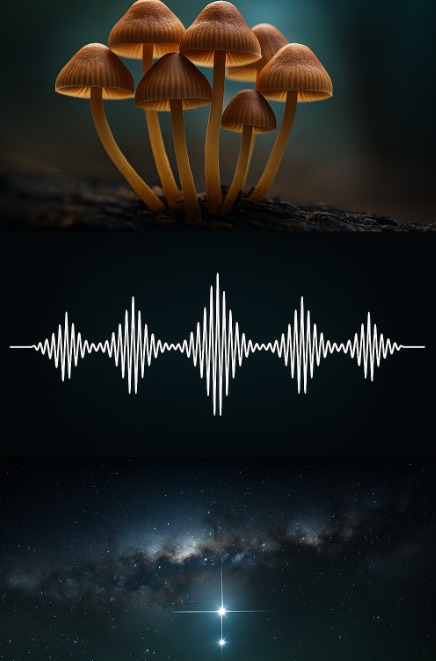
The Universe as a Symphony — Patterns of Resonant Self-Organization
When we zoom out to the grandest scales, resonance emerges as a principle of order. Complexity science shows that systems—whether neurons, ecosystems, or galaxies—often self-organize through rhythmic interactions, forming coherence without central control. Fireflies flashing together, audiences clapping in unison, and even galaxies spiraling into ordered forms reveal the same principle: synchronization is a natural property of connected systems.
This challenges the assumption that order must be imposed from outside. Instead, resonance itself may be the architect of coherence across scales. Galaxies, atoms, and ecosystems all exhibit rhythmic organization that arises spontaneously. Resonance becomes the thread weaving pattern into the cosmos, linking the micro and the macro into a living symphony (Nazerian et al., 2024).
Summary: Listening to the Cosmic Song
➡ Quantum resonance influences the tiniest states of matter.
➡ Biological resonance binds perception and emotion into coherence.
➡ Cosmic resonance organizes systems into harmony without external control.
Together, these patterns suggest that existence itself is musical. The universe is not silent—it hums, pulses, and sings. To live consciously is to listen to this symphony, to align with its rhythm, and to recognize that we are both musicians and instruments within the music of creation.
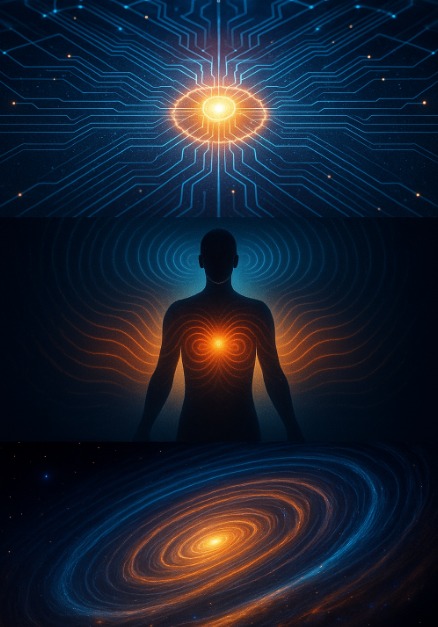
Reflection Questions
1. What rhythms—emotional, physical, or natural—guide your sense of harmony in daily life?
2. How might consciously tuning to your body’s natural cycles—heartbeat, breath, sleep—shift your awareness of connection?
3. Have you ever felt resonance with your surroundings—through music, nature, or silence—and what did it reveal about your place in the universe?
4. What would it mean to see yourself not as separate from the cosmos, but as a note in its ongoing melody?
[Free Video – Complexity in a Conscious Universe 28 Min]
(I’m an GAIA affiliate — watching through my link may earn me a small commission. Thank you for your support)
References: Aerts, C. (2021). Probing the interior physics of stars through asteroseismology. Reviews of Modern Physics, 93(1), 015001. https://doi.org/10.1103/RevModPhys.93.015001
Kitzman, J. M., Lane, J. R., Undershute, C., Harrington, P. M., Beysengulov, N. R., Mikolas, C. A., Murch, K. W., & Pollanen, J. (2023). Phononic bath engineering of a superconducting qubit. Nature Communications, 14(1), 3910. https://doi.org/10.1038/s41467-023-39682-0
Nazerian, A., Hart, J. D., Lodi, M., & Sorrentino, F. (2024). The efficiency of synchronization dynamics and the role of network syncreactivity. Nature Communications, 15, 9003. https://doi.org/10.1038/s41467-024-52486-0
Singer, W. (2021). Neuronal oscillations: An integrative principle for perception and cognition. Trends in Cognitive Sciences, 25(5), 365–378. https://doi.org/10.1016/j.tics.2021.02.002

The Hidden Dimension of Time — Cycles, Arrows, and the Flow of Existence
The Arrow of Time — Why the Universe Moves Forward
Among the most profound mysteries in science is why time seems to move in only one direction. The basic laws of physics allow for reversibility, yet our lived experience does not. We remember the past, not the future. Stars ignite and burn out, but never in reverse. Entropy—the universal tendency toward increasing disorder—creates a cosmic “arrow of time.” This arrow guides everything from the collapse of stars to the aging of our cells.
Recent advances in cosmology suggest that this asymmetry may be more than a byproduct of physical processes. It could be a fundamental condition for existence itself, a hidden law that allows the universe to evolve and consciousness to unfold. Without time’s arrow, there would be no story—no past to learn from, no future to imagine. Time moves forward, and in its wake, it weaves the very fabric of becoming (Di Valentino, Melchiorri, & Silk, 2021).
Cycles of Time — Rhythms in Nature and Mind
Yet time is not only linear—it is cyclical. The universe moves in spirals as much as straight lines. Planets orbit, seasons turn, tides rise and fall. Our own bodies mirror this cyclical truth: the beating of the heart, the breath moving in and out, the circadian rhythms aligning our sleep and wakefulness with the rising sun. Neuroscience shows that the brain relies on oscillatory rhythms to organize perception and action, linking our inner processes to the cycles of the world (Partch, Green, & Takahashi, 2021).
Across cultures, ancient traditions spoke of time as a wheel rather than an arrow. Agricultural societies honored planting and harvest cycles, while spiritual practices recognized cycles of death and rebirth. Modern science is now rediscovering this wisdom. Studies of ecosystems, biological renewal, and mental health reveal that cyclical rhythms are not secondary—they are essential for balance, stability, and resilience (Dollish, Tsyglakova, & McClung, 2024).

Time and Consciousness — Stretching and Folding the Moment
Time is not experienced the same by everyone, or even by ourselves in different moments. A single hour can feel like an eternity during suffering, while a day in the flow of creativity can pass in what feels like minutes. Psychology shows that emotion, memory, and attention all bend our sense of duration. Neuroscience adds that consciousness itself may arise through the integration of temporal windows—the brain weaving milliseconds into a continuous now, and connecting past with possible futures (Tsao, Sugar, & Lu, 2022).
This elasticity hints at something extraordinary: time is not just measured, it is lived. It bends and stretches with our awareness, teaching us that each moment is not fixed but alive with possibility. To become aware of this is to awaken to the creative potential hidden in the present. Each choice, each breath, is a chance to shape how the story of time unfolds through us.
Summary: Living in Time’s Mystery
➡ Entropy and the arrow of time carry creation forward, ensuring a direction to the universe’s unfolding.
➡ Cycles of time bring rhythm, balance, and renewal to both nature and human life.
➡ Consciousness and perception of time remind us that the present is not static but deeply participatory.
Time is paradoxical: it is both arrow and circle, rigid in physics and fluid in experience. To honor time is to step into its rhythm—accepting change, embracing cycles, and recognizing the creative elasticity of the moment. Time is not just something we measure; it is the very canvas upon which life paints its story.

Reflection Questions
1. When do you feel time expand—during creativity, stillness, or connection?
2. How do natural cycles—daily, seasonal, or personal—shape the ways you grow and renew?
3. What stories do you carry about the past, and how do they guide your present choices?
4. If each moment is a living gateway of possibility, how would you step into it differently today?
[Free Video – Geometry of Universe Connectedness 43 Min]
(I’m an GAIA affiliate — watching through my link may earn me a small commission. Thank you for your support)
References: Di Valentino, E., Melchiorri, A., & Silk, J. (2021). Cosmology intertwined II: The Hubble constant tension. Astroparticle Physics, 131, 102605. https://doi.org/10.1016/j.astropartphys.2021.102605
Partch, C. L., Green, C. B., & Takahashi, J. S. (2021). Molecular architecture of the mammalian circadian clock. Trends in Cell Biology, 31(7), 556–571. https://doi.org/10.1016/j.tcb.2021.03.007
Tsao, A., Sugar, J., & Lu, E. (2022). The neural bases for timing of durations. Nature Reviews Neuroscience, 23(11), 646–665. https://doi.org/10.1038/s41583-022-00623-3
West, G. B. (2017). Universal scaling laws in biology and physics. Nature, 550(7674), 307–315. https://doi.org/10.1038/nature24038
Dollish, H. K., Tsyglakova, M., & McClung, C. A. (2024). Circadian rhythms and mood disorders: Time to see the light. Neuron, 112(1), 25–40. https://doi.org/10.1016/j.neuron.2023.09.023

The Conscious Cosmos — Light, Perception, and the Hidden Language of Reality
Light as the Messenger of the Universe
Light is more than what we see—it is the messenger of the cosmos. Every photon that reaches Earth carries ancient information. Some of the starlight we observe tonight began its journey billions of years ago, long before life even appeared on this planet. By decoding these signals, astronomers reconstruct the history of galaxies, the life cycles of stars, and even the echoes of the Big Bang. The universe writes its story in light, and human science is learning how to read it.
Yet light is not only cosmic; it is profoundly biological. Circadian biology has shown that daily exposure to natural light orchestrates our internal clocks, regulating sleep, mood, hormone production, and metabolism. Disruptions in light exposure—like artificial light at night or lack of sunlight during winter—have measurable impacts on mental health, immune function, and well-being. Light therefore serves as both cosmic historian and biological regulator, bridging the story of the universe with the rhythms of human life (Cajochen, Chellappa, & Schmidt, 2023; Gaston, Bennie, Davies, & Hopkins, 2013).
Perception and the Brain’s Dance with Light
Reality as we know it depends on how the brain interprets light. The eye captures photons, but it is the brain that transforms them into colors, shapes, depth, and motion. Neuroscience now shows that this process is not passive—the brain does not simply receive signals but predicts, interprets, and actively fills in gaps.
Predictive processing research reveals that perception is a constant dialogue between the external world and internal expectation. For example, when light enters the retina, the brain uses prior experience to guess what should be seen, adjusting the raw signals to create stability and meaning. This explains optical illusions and why two people can perceive the same environment in entirely different ways. Light supplies the raw material, but it is human consciousness that turns it into a living world of color, memory, and imagination (Parr, Pezzulo, & Friston, 2022; de Lange, Heilbron, & Kok, 2021).
This insight shifts how we understand reality itself. If perception is co-created, then what we see is not a mirror of the universe but a negotiated version of it. Light is the universal input, but consciousness is the sculptor.

The Hidden Language of Light in Quantum Physics
At the quantum level, light reveals mysteries that challenge our sense of reality. Photons, the smallest units of light, behave as both waves and particles—a paradox confirmed in countless experiments. Quantum entanglement demonstrates that photons can remain connected across vast distances, with the state of one instantly influencing the other. This phenomenon suggests that light may carry not only energy and information but also connections that transcend space itself.
Quantum optics researchers are now exploring how manipulating light at this level could lead to new technologies in communication, computing, and sensing. Entangled photons could one day form the backbone of ultra-secure quantum networks or provide tools for probing the structure of reality itself. These findings suggest that light is more than a physical entity—it is a universal language written into the code of existence, linking the microscopic to the cosmic (Zeilinger, 2022; Pan et al., 2012).
Summary: Living in a Universe of Light
➡ Light is history: photons carry cosmic memory across billions of years.
➡ Light is rhythm: it synchronizes biological clocks and health.
➡ Light is meaning: perception transforms photons into experience.
➡ Light is connection: quantum physics reveals its role in non-local links.
The cosmos is not silent—it speaks in light. Every sunrise entrains our biology. Every star overhead is a messenger from deep time. Every neural spark in the brain is a conversation between photons and perception. To live consciously is to recognize that we are participants in this luminous dialogue. The more we learn to see light as history, rhythm, meaning, and connection, the more we recognize our place as living beings inside a radiant, intelligent cosmos.

Reflection Questions
1. How does natural light shape your daily rhythms and sense of well-being?
2. When you look at starlight, what story of the past does it awaken in you?
3. How does knowing that perception is co-created with light change how you see your life?
4. If light is the hidden language of the cosmos, how can you begin listening to it more deeply in your daily life?
[Free Vide – Physics of a Geometric Universe 51 Min]
(I’m an GAIA affiliate — watching through my link may earn me a small commission. Thank you for your support)
References: Cajochen, C., Chellappa, S. L., & Schmidt, C. (2023). Circadian rhythms, light, and sleep. Nature Reviews Neuroscience, 24(1), 7–23. https://doi.org/10.1038/s41583-022-00639-9
de Lange, F. P., Heilbron, M., & Kok, P. (2021). How do expectations shape perception? Trends in Cognitive Sciences, 25(5), 365–376. https://doi.org/10.1016/j.tics.2021.02.005
Gaston, K. J., Bennie, J., Davies, T. W., & Hopkins, J. (2013). The ecological impacts of nighttime light pollution: A mechanistic appraisal. Biological Reviews, 88(4), 912–927. https://doi.org/10.1111/brv.12036
Pan, J.-W., Chen, Z.-B., Lu, C.-Y., Weinfurter, H., Zeilinger, A., & Żukowski, M. (2012). Multiphoton entanglement and interferometry. Reviews of Modern Physics, 84(2), 777–838. https://doi.org/10.1103/RevModPhys.84.777
Parr, T., Pezzulo, G., & Friston, K. J. (2022). Active inference: The free energy principle in mind, brain, and behavior. Nature Reviews Neuroscience, 23(12), 758–770. https://doi.org/10.1038/s41583-022-00631-3
Zeilinger, A. (2022). Quantum entanglement: A review of experimental progress. Reviews of Modern Physics, 94(3), 035001. https://doi.org/10.1103/RevModPhys.94.035001
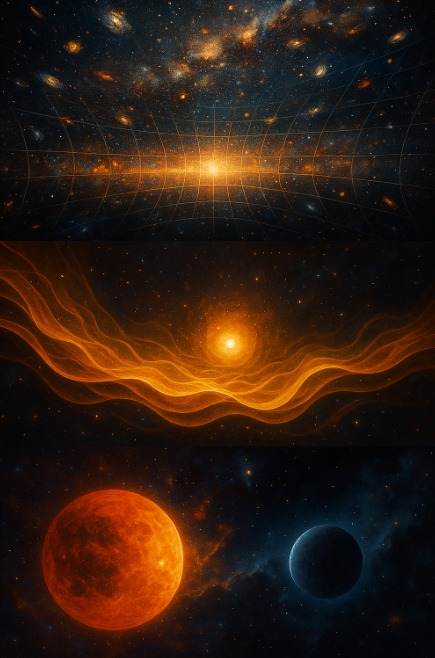
Dark Energy and the Expanding Cosmos — Unveiling the Universe’s Hidden Force
Introduction — Beyond Information and Boundaries
In exploring the holographic principle and the simulation hypothesis, we encountered ideas that reality may be rooted in hidden codes, boundaries, and informational structures. But information alone does not capture the full mystery of existence. Beneath the galaxies and woven into spacetime itself lies another puzzle—an invisible force accelerating the expansion of the universe.
This force, known as dark energy, is as strange as any simulation. Where holography asks what reality is made of, dark energy asks how reality evolves. It is the silent engine of cosmic motion, the driver of destiny, and one of the most profound mysteries of modern science (Riess et al., 2022).
The Mystery of Acceleration
In 1998, two independent teams of astronomers observed that distant supernovae were dimmer than expected. The finding revealed that the universe is not just expanding, but accelerating—galaxies drifting apart faster and faster over time.
This overturned long-standing expectations. For decades, scientists believed gravity would eventually slow cosmic expansion, perhaps even causing collapse. Instead, the cosmos is rushing outward under the influence of something unseen. This force—called dark energy—is thought to make up nearly 70% of the universe’s total content, dwarfing matter and dark matter combined.
Yet no one knows what it is. Is dark energy a fundamental property of spacetime itself, or is it the signature of an undiscovered field? Just as the simulation hypothesis suggests hidden programming behind reality, dark energy suggests hidden physics within the universe’s very fabric (Abbott et al., 2022).
Quintessence and New Physics
The simplest explanation is Einstein’s cosmological constant—a fixed energy of empty space that pushes everything outward. But some scientists propose a more dynamic solution: quintessence, a field that evolves with time. Unlike a constant, quintessence could grow or fade across cosmic history, subtly changing the universe’s fate.
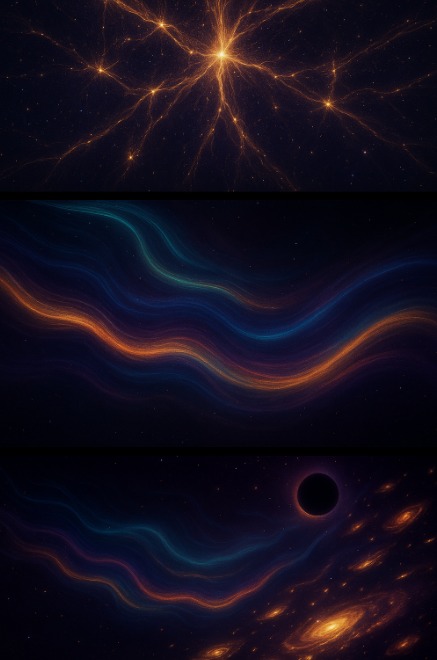
If proven, quintessence would expand our understanding beyond the Standard Model of particle physics. It would mean spacetime itself carries fields and energies we have not yet discovered. In this sense, quintessence mirrors holography: just as space may encode information on boundaries, it may also store evolving energies that shape cosmic history (Perivolaropoulos & Skara, 2022).
Current missions, such as the Vera Rubin Observatory and the Euclid Space Telescope, are designed to test these models. By mapping billions of galaxies, they may reveal whether dark energy is steady or shifting—a clue to whether reality follows a fixed script or an evolving one.
Cosmic Fate — Forever Expanding or Something Else?
Dark energy is not just about the present—it defines the universe’s ultimate destiny.
If dark energy is constant, the cosmos will expand forever, becoming colder and lonelier as galaxies drift beyond reach. If it strengthens, a Big Rip could tear apart stars, planets, and even atoms themselves. If it weakens or reverses, gravity could one day halt expansion, leading to a collapse or cyclic Big Bounce.
Where the simulation hypothesis raises questions of code and design, dark energy raises questions of destiny and impermanence. Both invite us to see reality not as static, but as an unfolding process guided by hidden frameworks (Weinberg, 1989).
Dark Energy and the Nature of Reality
Why does dark energy exist at all? Why does it have the exact value it does? Some scientists argue that if its strength were even slightly different, galaxies, stars, and planets might never have formed. This perspective ties dark energy to the anthropic principle—the suggestion that the universe seems fine-tuned because we exist within it.
Others imagine dark energy as evidence of deeper structures in the cosmos, such as a multiverse where different universes have different values. In that picture, ours is simply one bubble where conditions allow life. Just as holography hints that our universe may be projected from a boundary, dark energy hints that we may be living within one universe among many, shaped by laws far beyond our reach (Riess et al., 2022).
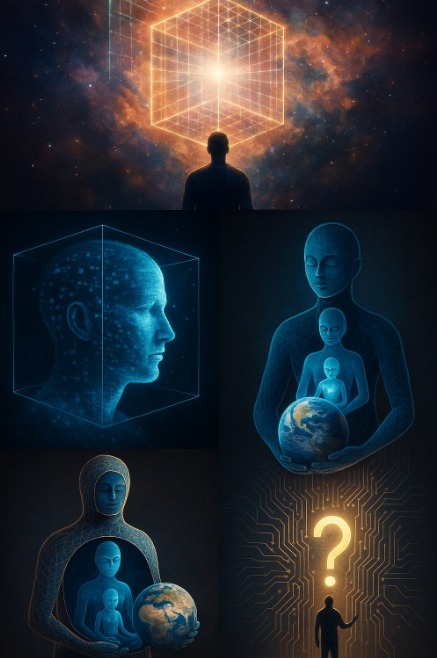
Summary: A Universe of Hidden Frameworks
➡ Holography and simulation propose reality as information.
➡ Dark energy reveals a hidden force shaping motion and destiny.
➡ Quintessence and cosmological models suggest spacetime may carry evolving energies.
Both perspectives show the universe is guided by frameworks that are invisible yet decisive.
Together, these insights remind us that reality is deeper than appearances. Whether written in code, projected as information, or propelled by hidden energy, the universe challenges us to expand our imagination. To seek dark energy is to seek not only physics, but meaning—to ask what holds the cosmos together and what drives it forward.
Reflection Questions:
1. If reality is shaped by both information and energy, how do they weave together to form existence?
2. What does the mystery of dark energy reveal about the limits of human knowledge?
3. How does contemplating cosmic destiny influence your present-day choices?
4. Do you see dark energy as fine-tuned for life, or as one outcome among infinite universes?
[Free Video – The Holographic Universe 44 Min]
(I’m an GAIA affiliate — watching through my link may earn me a small commission. Thank you for your support)
References: Abbott, T. M. C., et al. (DES Collaboration). (2022). Dark Energy Survey Year 3 results: Cosmological constraints from galaxy clustering and weak lensing. Physical Review D, 105(2), 023520. https://doi.org/10.1103/PhysRevD.105.023520
Perivolaropoulos, L., & Skara, F. (2022). Challenges for ΛCDM: An update. New Astronomy Reviews, 95, 101659. https://doi.org/10.1016/j.newar.2022.101659
Riess, A. G., Yuan, W., Macri, L. M., Scolnic, D., Brout, D., Casertano, S., … Zinn, J. C. (2022). A comprehensive measurement of the local value of the Hubble constant with 1 km s⁻¹ Mpc⁻¹ uncertainty from the Hubble Space Telescope and the SH0ES Team. The Astrophysical Journal Letters, 934(1), L7. https://doi.org/10.3847/2041-8213/ac5c5b
Weinberg, S. (1989). The cosmological constant problem. Reviews of Modern Physics, 61(1), 1–23. https://doi.org/10.1103/RevModPhys.61.1
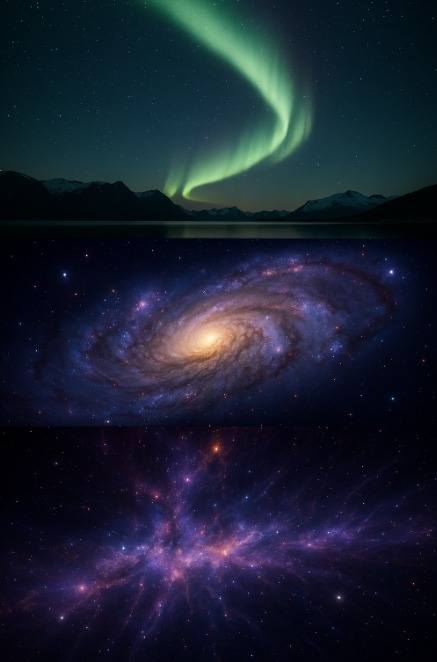
The Power of Awe: How Wonder Shapes Human Imagination and Discovery
Awe as a Catalyst for Discovery
From the first humans who gazed at the Milky Way to the scientists who send telescopes beyond Earth’s orbit, the universe has always been a wellspring of awe. Unlike ordinary curiosity, awe comes with a sense of vastness—a recognition that we are part of something much greater than ourselves.
Modern research shows that awe is not only a feeling but also a driver of discovery. It shifts perception, expands thinking, and opens us to new ways of understanding the cosmos. Studies suggest that people exposed to awe-inspiring experiences show greater creativity, more prosocial behavior, and deeper motivation to explore unknowns. In this sense, awe is one of the universe’s greatest gifts: a spark that transforms wonder into knowledge (Monroy, Hidalgo, & Keltner, 2022).
Awe and Brain Function — Expanding Neural Horizons
Neuroscience reveals that awe alters activity in the default mode network, a brain system linked to self-focus and habitual thought. When awe takes hold, this network quiets, and broader, more integrative patterns emerge. Instead of narrowing our attention to immediate concerns, awe allows us to perceive the “big picture”—to connect dots across time and space.
This may explain why encounters with cosmic phenomena—eclipses, auroras, or the sight of galaxies through a telescope—so often inspire both scientific inquiry and spiritual reflection. The universe acts as a mirror, showing us both our smallness and our capacity for boundless imagination. Awe does not only shift mood; it rewires how the brain approaches reality itself (Prade, 2022).
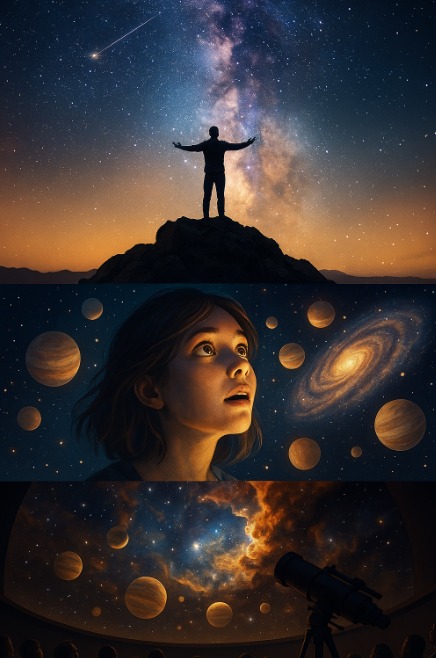
Awe in Education and Collective Growth
Astronomy and space science are uniquely positioned to cultivate awe. Classrooms that include experiences of the night sky, virtual reality journeys through galaxies, or storytelling rooted in cosmic imagery engage students in ways facts alone cannot. Research suggests that awe-based learning environments improve long-term retention, strengthen motivation, and inspire greater engagement with science, technology, engineering, and mathematics (Ochadleus, Kirby, & Scollon, 2023).
On a collective level, awe fosters humility and a sense of belonging to something larger. As humanity faces challenges that stretch across the globe—climate change, sustainability, and the search for extraterrestrial life—awe can be a unifying force. Looking up at the stars, we are reminded that we share not only one planet but one universe, and that our destiny is deeply interwoven with the cosmos.
The Universe as the Great Teacher
Perhaps the most profound truth is that the universe itself is our greatest teacher of awe. Every discovery—black holes bending spacetime, dark matter shaping galaxies, or the first glimpses of the cosmic microwave background—invites us to stand at the edge of mystery. Each breakthrough reminds us that the cosmos is not silent but calling, asking us to listen with both heart and mind.
The role of awe, then, is not just to inspire scientists but to awaken all of us to our participation in the cosmic story. Through awe, we realize that knowledge and meaning are not separate. The universe is not something we merely observe—it is something we feel, respond to, and grow with (Ochadleus, Kirby, & Scollon, 2023).
Summary: Awe as the Spark of Expansion
➡ Awe is not just an emotion—it is a catalyst for curiosity, imagination, and discovery.
➡ Neuroscience shows that awe shifts brain networks toward openness and creativity.
➡ Astronomy and cosmic experiences awaken awe, shaping how we learn and engage with science.
➡ On a societal level, awe fosters connection and humility, helping humanity unite around shared cosmic belonging
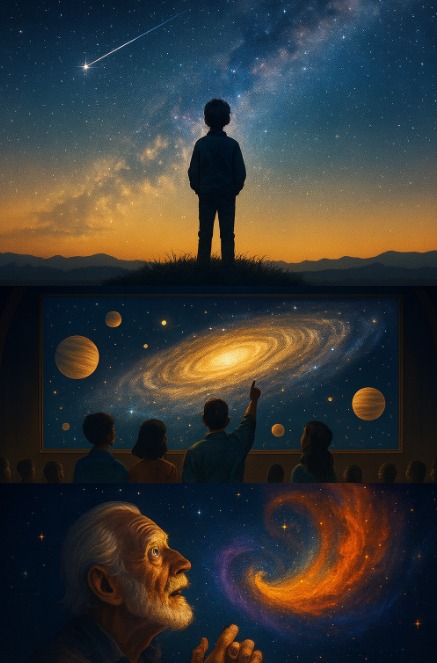
The universe is more than vast matter and energy—it is a field of inspiration. To embrace awe is to embrace the cosmos itself, not only as an object of study but as a living source of transformation.
Reflection Questions
1. When was the last time you looked at the night sky and felt awe—what did it awaken in you?
2. How can cosmic experiences of awe keep curiosity alive in your daily life?
3. What role should astronomy and space exploration play in inspiring future generations?
4. How might cultivating awe help humanity see itself as part of a greater cosmic story?
[Free Video – Tapping into the Secrets of the Universe 30 Min]
(I’m an GAIA affiliate — watching through my link may earn me a small commission. Thank you for your support)
References: Monroy, M., Hidalgo, D., & Keltner, D. (2022). Awe as a pathway to mental and physical health. Perspectives on Psychological Science, 17(2), 462–482. https://doi.org/10.1177/17456916221094856
Ochadleus, C., Kirby, C., & Scollon, C. N. (2023). It’s awe-fully unfamiliar: The effect of familiarity on awe within a virtual reality setting. Frontiers in Psychology, 14, 1096283. https://doi.org/10.3389/fpsyg.2023.1096283
Prade, C. (2022). Awe in childhood: Conjectures about a still unexplored research area. Frontiers in Psychology, 13, 791534. https://doi.org/10.3389/fpsyg.2022.791534

The Power of Attention: How Focus Shapes Reality
Attention as the Architect of Experience
Every day, countless sensations, thoughts, and possibilities pass through us, but only a fraction becomes part of our lived reality. The deciding factor is attention. Neuroscience shows that what we focus on directly shapes perception—altering how we interpret the world and what we remember. Attention filters vast input into meaningful experience, creating the framework of reality itself.
Rather than being passive observers, we are active sculptors. By training attention, we can reshape how the brain prioritizes information, opening doors to creativity, resilience, and well-being. Attention is not just noticing—it is participation in the building of our universe (Nobre & Kastner, 2014).
Attention, Emotion, and Energy
Focus and emotion are deeply connected. Studies reveal that emotionally charged experiences are more likely to capture and hold our attention, leaving stronger imprints in memory. But the reverse is also true: where attention flows, emotion follows.
This is why mindfulness practices—anchoring attention to breath, body, or the present moment—reduce stress and enhance emotional balance. The act of focusing shifts neural circuits and regulates the autonomic nervous system. In this sense, attention is not simply cognitive; it is energetic, channeling emotion and vitality into chosen directions.
When applied to personal growth, this principle becomes transformative. Attention directed toward gratitude strengthens emotional resilience and rewires the brain toward positivity. Likewise, focusing on challenges as opportunities shifts perception, turning obstacles into gateways of growth. Attention is the lever by which the mind lifts itself into new states of being (Mather, 2020).

Collective Attention — A Shared Field
Attention doesn’t just shape individual experience—it influences groups and societies. Social neuroscience shows that shared attention creates alignment between people’s brain activity, increasing empathy, trust, and cooperation.
When large groups focus on the same event—whether a solar eclipse, a concert, or a moment of crisis—the experience takes on a collective intensity. The universe of meaning expands through shared focus. Shared attention magnifies emotional energy, creating a field in which new possibilities can emerge more powerfully than in isolation.
This is why cultural rituals, ceremonies, and scientific breakthroughs shared across humanity have such lasting impact. The universe reflects our focus back to us, not only individually but collectively, reminding us that consciousness is not solitary but interconnected (Redcay & Schilbach, 2019).
Attention and the Universe — A Mirror of Creation
In many ways, attention mirrors the fabric of the cosmos itself. Just as galaxies cluster around invisible webs of dark matter, our thoughts and experiences cluster around the gravitational pull of attention. The act of noticing is creative; it draws certain possibilities into form while letting others fade into the background.
This suggests that the universe may not be an indifferent backdrop but a participatory field, one that responds to the way awareness is directed. By focusing with clarity and intention, we do not only change our inner lives—we may also be tuning into the deeper order of the cosmos, aligning our perception with the rhythms of universal intelligence (Nobre & Kastner, 2014).
Summary: Sculpting Reality Through Focus
➡ Attention filters experience, shaping perception and memory.
➡ Emotional energy and attention are interwoven, creating momentum for growth or stress.
➡ Shared attention builds empathy and unites communities.
➡ At its deepest, attention reflects the creative architecture of the cosmos itself.
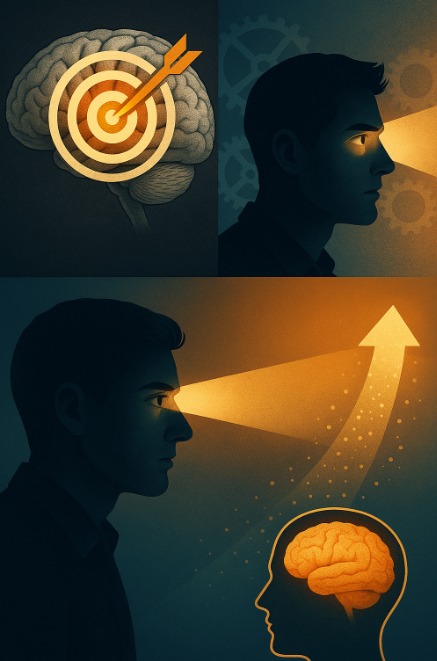
To direct attention is to direct life. When you choose where to place your focus, you align with the creative process of the universe. In every moment, attention offers a choice: to scatter awareness across distractions, or to shape reality with presence, clarity, and meaning.
Reflection Questions
1. Where does your attention naturally flow each day, and how does it shape your experiences?
2. How could you train attention to nurture peace, growth, or creativity?
3. What role does collective attention play in shaping culture and shared meaning?
4. How does the universe reflect back the focus you consistently hold?
[Free Video – Notes from the Universe 56 Min]
(I’m an GAIA affiliate — watching through my link may earn me a small commission. Thank you for your support)
References: Mather, M. (2020). Affective influences on attention and memory. Trends in Cognitive Sciences, 24(7), 565–578. https://doi.org/10.1016/j.tics.2020.04.004
Nobre, A. C., & Kastner, S. (2014). Attention. In A. C. Nobre & S. Kastner (Eds.), The Oxford Handbook of Attention (pp. 1–20). Oxford University Press. https://doi.org/10.1093/oxfordhb/9780199675111.013.040
Redcay, E., & Schilbach, L. (2019). Using second-person neuroscience to elucidate the mechanisms of social interaction. Nature Reviews Neuroscience, 20(8), 495–505. https://doi.org/10.1038/s41583-019-0179-4
